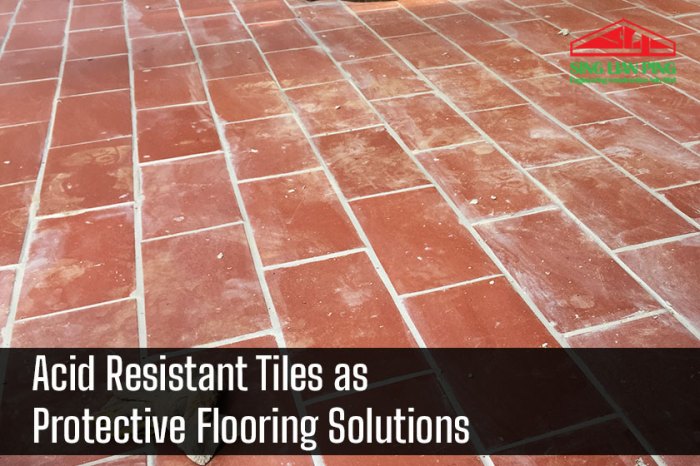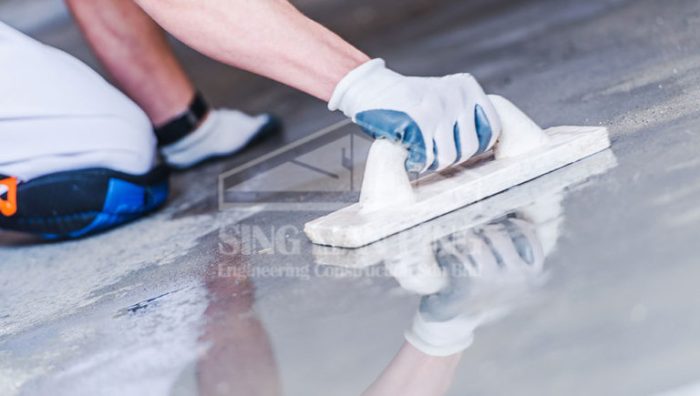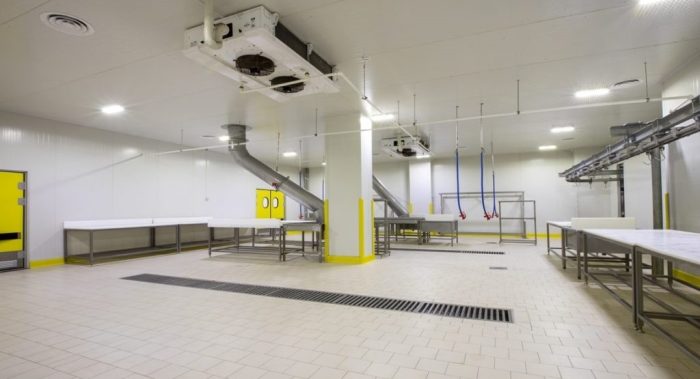In the realm of bathroom design, safety should always be a top priority. Bathrooms often house a variety of chemicals, from cleaning agents to personal care products, each posing potential hazards if not handled properly. Acid-resistant tiles emerge as a crucial solution in mitigating these risks, providing a durable and chemically inert surface that safeguards against the corrosive effects of these substances.
The exceptional properties of acid-resistant tiles make them ideally suited for bathroom environments. Their chemical inertness ensures they remain unaffected by harsh chemicals, while their durability withstands the wear and tear of daily use. Furthermore, their resistance to staining prevents unsightly marks and discoloration, maintaining a pristine and hygienic space.
Chemical Safety in Bathrooms
Bathrooms are a hub of various chemical products, ranging from personal care items to cleaning agents. Ensuring chemical safety in bathrooms is paramount to safeguard the health of occupants and prevent accidents.
Common chemicals found in bathrooms include:
- Cleaning agents: Bleach, ammonia, drain cleaners
- Personal care products: Shampoo, conditioner, toothpaste
- Medicines: Prescriptions, over-the-counter drugs
These chemicals pose potential hazards such as:
- Irritations and allergies: Skin, eye, and respiratory tract
- Chemical burns: Contact with corrosive substances
- Poisoning: Ingestion or inhalation of toxic chemicals
Acid-resistant tiles play a crucial role in mitigating chemical risks in bathrooms. They are designed to withstand the corrosive effects of acids, alkalis, and other harsh chemicals commonly found in bathroom environments.
Properties of Acid-Resistant Tiles
Acid-resistant tiles are specially designed to withstand the corrosive effects of chemicals, making them ideal for use in environments where chemical safety is paramount. These tiles possess a unique set of properties that contribute to their effectiveness in such applications.
One of the key properties of acid-resistant tiles is their chemical inertness. They are made from materials that do not react with acids or other corrosive substances, ensuring their stability and longevity even when exposed to harsh chemicals. This inertness prevents the tiles from deteriorating or releasing harmful fumes, maintaining a safe and hygienic environment.
Acid-resistant tiles are also highly durable and resistant to wear and tear. They are typically made from dense and robust materials, such as porcelain or ceramic, which can withstand heavy foot traffic and the impact of chemicals. This durability ensures that the tiles retain their integrity and functionality over extended periods, even in demanding environments.
Additionally, acid-resistant tiles are highly resistant to staining and discoloration. The non-porous nature of these tiles prevents the absorption of liquids and chemicals, making them easy to clean and maintain. This resistance to staining ensures that the tiles retain their aesthetic appeal and contribute to a clean and professional appearance in chemical safety applications.
Examples of Acid-Resistant Tile Materials
Various materials are used in the production of acid-resistant tiles, each offering specific advantages. Some of the most common materials include:
- Porcelain: A dense and durable material with low porosity and high resistance to chemicals.
- Ceramic: Similar to porcelain, but with a slightly higher porosity. It is still highly resistant to acids and other corrosive substances.
- Vitrified tiles: Made from a mixture of clay and glass, vitrified tiles are extremely dense and impervious to liquids and chemicals.
- Stoneware: A durable and non-porous material that is resistant to acids and other harsh chemicals.
Design Considerations for Acid-Resistant Tiles
When selecting acid-resistant tiles for bathroom applications, several design considerations come into play. These factors influence the overall performance and aesthetic appeal of the tiles in the harsh chemical environment of bathrooms.
Tile Size, Shape, and Texture
Tile size, shape, and texture significantly impact chemical resistance. Smaller tiles provide more grout lines, which can be vulnerable to acid penetration if not properly sealed. Larger tiles minimize grout lines, reducing the risk of acid seepage.
Tile shape also plays a role. Rounded edges are preferable to sharp edges, as they reduce the likelihood of chipping or cracking, which can compromise the tile’s acid resistance.
Texture is another factor to consider. Smooth tiles are easier to clean and maintain, while textured tiles can provide better slip resistance. However, textured tiles may require more frequent cleaning to prevent dirt and grime buildup.
Grout Selection and Installation
The choice of grout and proper installation techniques are crucial for acid-resistant tile systems. Acid-resistant grout is specifically designed to withstand chemical exposure, preventing the penetration of acids into the substrate.
During installation, proper grouting techniques ensure a tight seal between tiles and prevent acid seepage. The use of grout spacers ensures uniform grout lines and prevents the grout from shrinking or cracking over time.
Installation and Maintenance of Acid-Resistant Tiles
Ensuring proper installation and maintenance of acid-resistant tiles in bathrooms is crucial for maximizing their durability and performance. This involves selecting compatible adhesives and sealants, adhering to precise installation procedures, and implementing regular cleaning practices to preserve the integrity of the tiles.
Installation Procedures
When installing acid-resistant tiles in bathrooms, meticulous attention to detail is essential. The surface should be thoroughly prepared, ensuring it is level, clean, and free from debris. The tiles must be laid out in a precise manner, maintaining consistent spacing and alignment.
The use of spacers can assist in achieving a uniform and aesthetically pleasing result.
Adhesives and Sealants
The choice of adhesives and sealants is critical for the long-term performance of acid-resistant tiles. Selecting products specifically designed for this purpose ensures optimal adhesion and resistance to chemical exposure. These specialized adhesives and sealants create a strong bond between the tiles and the substrate, preventing moisture penetration and maintaining the integrity of the installation.
Maintenance and Cleaning
Regular maintenance and cleaning practices are essential for preserving the appearance and functionality of acid-resistant tiles. Daily cleaning with mild, non-abrasive cleaning agents helps remove dirt and grime without damaging the tiles. Periodic deep cleaning with specialized tile cleaners can effectively remove stubborn stains and restore the tiles’ original luster.
It is important to avoid using harsh chemicals or abrasive cleaners, as these can damage the tiles’ surface and compromise their protective properties.
Case Studies and Applications
Acid-resistant tiles have proven their worth in various bathroom environments, delivering exceptional performance and safety. Here are some notable case studies and applications:
Residential Bathroom
In a residential bathroom renovation, acid-resistant tiles were installed on the floor and shower walls. The homeowner frequently used harsh cleaning agents and acidic hair care products. The tiles effectively resisted chemical damage, maintaining their pristine appearance and protecting the bathroom surfaces from corrosion.
Commercial Gym
A commercial gym installed acid-resistant tiles in its showers and locker rooms. The tiles withstood the harsh chemicals used for cleaning and disinfection, preventing damage to the surfaces and ensuring a safe and hygienic environment for gym members.
Hospital Bathroom
A hospital bathroom was fitted with acid-resistant tiles to enhance chemical safety for patients and staff. The tiles provided excellent resistance to bodily fluids, cleaning solutions, and disinfectants, reducing the risk of chemical burns and contamination.
Challenges and Lessons Learned
While acid-resistant tiles offer significant benefits, certain challenges and lessons can be learned during their installation and use:
- Proper Installation: Acid-resistant tiles require specialized installation techniques to ensure proper adhesion and chemical resistance.
- Maintenance: Regular cleaning and maintenance are essential to preserve the integrity of acid-resistant tiles and prevent damage.
- Acid Concentration: The tiles’ resistance varies depending on the concentration and type of acid exposure. It’s crucial to assess the specific chemical environment before selecting tiles.
Cost and Value Considerations
Acid-resistant tiles are generally more expensive than standard bathroom flooring options like ceramic or porcelain tiles. However, they offer significant long-term value and return on investment.
Initial Cost Comparison
The cost of acid-resistant tiles varies depending on the material, size, and design. Generally, they range from $5 to $20 per square foot, while ceramic or porcelain tiles cost around $2 to $10 per square foot.
Long-Term Value
Acid-resistant tiles are highly durable and resistant to harsh chemicals, acids, and stains. This means they are less likely to need repairs or replacements, saving you money in the long run. They also have a longer lifespan than standard tiles, typically lasting for decades with proper maintenance.
Maintenance and Repair Savings
Acid-resistant tiles require minimal maintenance, making them cost-effective over time. They are easy to clean and do not require special cleaning agents. Additionally, their resistance to damage reduces the likelihood of costly repairs or replacements.
Last Recap
In conclusion, acid-resistant tiles play an indispensable role in enhancing chemical safety in bathrooms. Their unique properties provide a protective barrier against corrosive substances, ensuring a safe and healthy environment for occupants. By investing in acid-resistant tiles, homeowners can create bathrooms that are both aesthetically pleasing and chemically sound, safeguarding their well-being and preserving the integrity of their bathroom surfaces for years to come.



